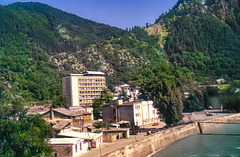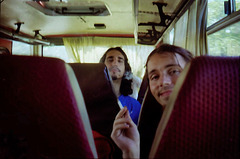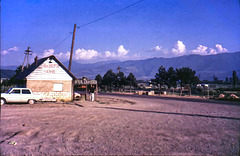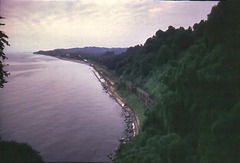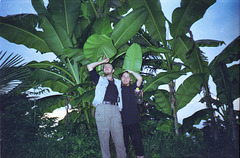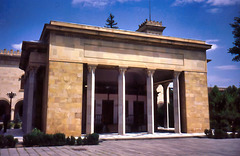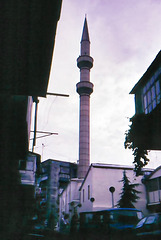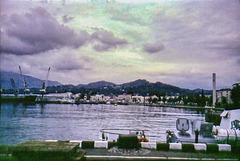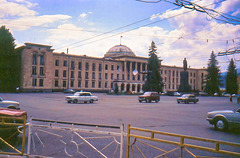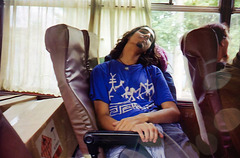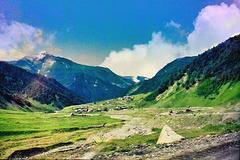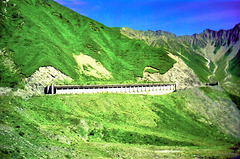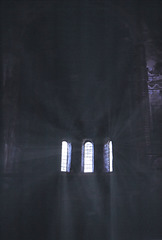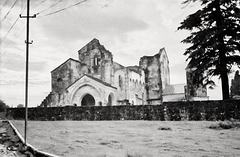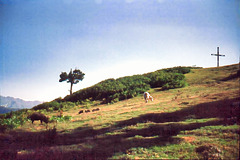m̌ ḫ's photos
Borjomi town
| |
|
|
|
Borjomi, a resort town in south-central Georgia, was a popular destination during the Soviet era due to its mineral springs and beautiful natural surroundings. The town's mineral water, sourced from the springs of the Borjomi Gorge, is one of Georgia's largest exports and is well-known throughout the former Soviet region. During the Soviet era, Borjomi was a favorite summer resort for the aristocracy, earning it the nickname "the pearl of Caucasus"
Already in the 1860s, new hotels were built, and an administration for mineral waters was established. Following the Red Army invasion of Georgia in 1921, the Soviet regime confiscated all aristocratic mansions and turned them into sanatoria, frequented by the Communist party elite. Despite the dissolution of the Soviet Union leading to a decline in Borjomi's popularity, remnants of its socialist past can still be seen today. The town's architecture, run-down houses, and former hotels bear witness to its Soviet history. The town is now making efforts to revive its status as a leading tourist destination, with a focus on ecotourism and agrotourism.
The 'old times'
| |
|
|
|
It might be hard to remember, but in some parts of the world, smoking bans are a relatively recent development compared to Western countries. Around the turn of the millennium, smoking was still seen as a form of personal freedom in these places. While it's important to acknowledge the broader implications for public health, I want to share a glimpse of what some might call the 'good old days' from my time at university. We found joy in the simplest things, like smoking inexpensive Soviet-era cigarettes, a welcome distraction from the endless, exhausting journeys on buses and trains.
The photo accompanying this story features me, and credit for the shot goes to my friend RoKo.
In the middle of nowhere
| |
|
|
|
Batumi Botanical Garden
| |
|
|
|
Batumi Botanical Garden is located at the distance of 9 km from the center of Batumi, occupying the area approximately 1 km stripe of Southern-Western section of the coastline located between the river Chakvistskali estuary and the Green Cape. Not long time ago the area was totally covered with Kolkheti type forest (beech, chestnut, linden) and evergreen sub-forest. Visitors can enjoy hiking, walking, picnicking, and camping inside the garden.
Under a banana tree
Batumi Botanical Garden
| |
|
|
Batumi Botanical Garden (est. 1912) is one of the largest and oldest botanical gardens in the world, covering an area of over 100 hectares and featuring over 5,000 species of plants from nine phyto-geographic areas.
Murderer's museum
| |
|
|
|
The Stalin Museum is a museum in Gori, Georgia dedicated to the life of Ioseb Besarionis dze Jughashvili alias Joseph Vissarionovich Stalin, the infamous Soviet dictator and mass murderer, who was born here. The museum retains its Soviet-era characteristics and was officially dedicated to Stalin in 1957 - I could not find any mention of the crimes, atrocities or horrors committed during Stalin's rule.
The complex of the museum includes the memorial house (on the photo) where the devil was born, his carriage, and a two-storey exhibition building. The exhibits are divided into six halls in roughly chronological order, and contain many items actually or allegedly owned by Stalin, including some of his office furniture, his personal effects, and gifts made to him over the years. The museum nowadays also has a separate room devoted to the period of repressions, which has existed since 2010.
About Gori, which offered nothing interesting. The reason is that the town was destroyed in the 1920 earthquake, and almost completely rebuilt in the Soviet period. An important industrial center in Soviet times, Gori suffered from an economic collapse and the outflow of the population during the years of a post-Soviet crisis of the 1990s.
Batumi Mosque
| |
|
|
|
Batumi Mosque - Orta Jame is located in Adjara, Batumi, on Kutaisi Street. It is one of the oldest buildings in Batumi. It was built during the Ottoman rule in 1886. Orta Jame is a typical example of late Ottoman provincial architecture. The golden dome of the building and the tall, white minaret draw attention from the distance and play an essential role in creating the multicultural urban environment of Batumi. Batumi Mosque is a large building with a rectangular plan, which has a high minaret in the corner and a large gilded dome in the center. The exterior of the building is plastered and painted in white. The facades are separated by rectangular windows, which are surrounded by profiled trims and crowned with flat "pediments". Rectangular windows on longitudinal facades are replaced by circular ones, above which are depicted the lying crescents. The east entrance is the most richly decorated. It is flanked by pilasters supported by a tall, helmet-shaped arch. A round window is cut in the arch tympanum. The windows on the facades are arranged in two tiers, although the interior space is united. The wooden gable roof relies on four free-standing round pillars. At the top of the middle section there is erected a dome with wooden poles. The ceiling, dome and railings of the cathedra are decorated with colorful decorative paintings.
Batumi port
| |
|
|
|
The Port of Batumi is a significant seaport located in the city of Batumi, Georgia, on the southeast coast of the Black Sea. It is the largest container, ferry, and general cargo seaport in Georgia, with a total capacity of 18 million tons per year and 5 terminals, including an oil terminal, dry cargo terminal, container terminal, railway-ferry crossing, and passenger terminal. The port has a long history dating back to the Roman Empire and is known for its geostrategic and natural advantages, such as its natural deep-water location, which allows large tonnage vessels to enter without crossing a canal and paying canal fees. The port provides a wide range of high-quality services, including cargo transshipment, warehousing, storage, and ship maintenance. It is also used as a major transit port for oil refining in Kazakhstan and Azerbaijan. The port plays a crucial role in the Eurasian and international trade network.
[see the hidden B/W version]
Cars of Kutaisi
| |
|
|
|
In 1999, the vehicles on the roads in Georgia were quite diverse. The most common car models were Lada Samara, Niva, Volga, O. Astra, VW Golf, H. Accent... The majority of cars on the road were old and damaged (described by some traveller as something straight out of 1975), with many spitting toxic fumes and probably many of these cars would not pass inspection in Europe.
ccording to the Georgia Department of Public Safety's 1999 Annual Report the motor vehicle travel continued to grow at a rate of 5% each year, and the data from the National Statistics Office of Georgia show that the number of registered vehicles increased from 762,200 units in 1999 to 1,490,200 units in 2021.
And one more observation. The policemen used whistles to stop the car and gather some pocket money to offset their extremely low wages. Locals said that the police only checked on in the morning, so the people who could not afford 'fines' would only drive in the afternoon.
The weariness of a low-cost travel
| |
|
|
|
Wonderful green mountains of Ossetian part of Cauc…
| |
|
|
|
South Ossetia is a very mountainous region located in the Caucasus at the juncture of Asia and Europe. It occupies the southern slopes of the Greater Caucasus mountain range and its foothills which are part of the Iberia Plain, a geographic plateau that is roughly in the center of South Ossetia. The Likhi Range shapes the western geographic boundary of South Ossetia, although the northwestern corner of South Ossetia is located west of the range. Before the Georgian–Ossetian conflict, roughly two-thirds of the population of South Ossetia was Ossetian and 25–30% was Georgian. The dispute surrounding the presence of the Ossetian people in the South Caucasus has been one of the causes of conflict. In the late 1980s, a separatist movement emerged in South Ossetia that sought secession from Georgia and unification with North Ossetia–Alania. In 1989, Soviet troops were sent to maintain peace. Shortly after Georgia gained its independence from the Soviet Union in 1991, heavy fighting broke out between Ossetian and Georgian forces, forcing thousands to flee South Ossetia. In 2008, South Ossetia saw a brief war between Russia and Georgia. Moscow subsequently recognized South Ossetia as an independent state, and began a process of closer ties that Georgia views as effective annexation. Russia should recognise also North Ossetia as an independent state, too - the logic says.
Wonderful green mountains and our story
| |
|
|
|
This photo might seem not to show much, except the excessive green colour. A fantastic green colour of the Greater Caucasus mountains. It has been taken randomly somewhere in South Ossetia.
Randomly, as our journey from Vladikavkaz to Georgia led through the chaotic area (de facto fragile independent from the government in Tbilisi) following the First South Ossetia War.
As suggested, our intention was to travel to Georgia on land, and improvising took us to an unforseen path, sitting in the marshrutka (routed taxicab) with locals, heading to Cxinvali and very quickly hop on another bus to Tbilisi...
Something about the God
| |
|
|
Inside the church darkness
| |
|
|
|
Bagrati cathedral in BW
| |
|
|
|
The Bagrati Cathedral was constructed in the 11th century and is a cruciform-shaped church with four free-standing piers supporting the dome. It has a three-apsed construction to the east, with an elongated western arm. On the second floor of both sides of the west arm, there are galleries where women from royal families would have prayed. The restoration works began in the 1950s, and continued for several decades. In 1994, under Patriarch Ilia II, a fund was created for the reconstruction of the cathedral, and major conservation works were concluded in 2012.
Somewhere along the road in Georgia
| |
|
|
Looks like a commercial for a fizzy drink somewhere from Midwest nowhere states of Amurika
Svaneti
| |
|
|
|
The Cross Over Mestia is just one of the many attractions and activities that make Mestia a must-visit destination in Georgia. Whether you're an adventure traveler, hiker, or cultural enthusiast, Mestia offers a range of experiences that showcase its natural beauty, rich history, and unique micro-culture.

